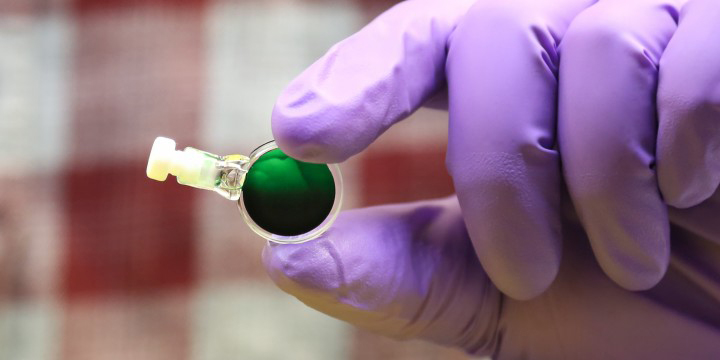Cyanobacterial Studies Examine Cellular Structure During Nitrogen Starvation
11/15/2017

Researchers from Washington University in St. Louis and ORNL are using neutrons to study what happens when cyanobacteria cell samples (pictured) are starved for nitrogen. They are especially interested in how this process affects phycobilisomes, large antenna protein complexes in the cells that harvest light for photosynthesis. A better understanding of this natural phenomenon could lead to improvements in artificial resources like solar panels. [Image credit: ORNL/Genevieve Martin.]
The Summary
Using nondestructive neutron scattering techniques, scientists are examining how single-celled organisms called cyanobacteria produce oxygen and obtain energy through photosynthesis. Collaborators are conducting a series of experiments to study the behavior of phycobilisomes—large antenna protein complexes in cyanobacteria cells. Phycobilisomes harvest light to initiate photosynthesis, and a better understanding of this process could help researchers design more efficient solar panels and other artificial structures that mimic natural systems. Neutrons can analyze these delicate structures without damaging or killing the cyanobacteria and with more spatial accuracy than other techniques like microscopy. Biological small-angle neutron scattering (bio-SANS) allows observing what’s happening at the nanoscale level in real time in a living cell.
Phycobilisomes attach to cellular membranes where the light-dependent reactions of photosynthesis take place. Changing the antenna complexes of the phycobilisomes can have dramatic and far-reaching consequences in cyanobacteria. Artificially modifying phycobilisomes by deleting certain genes in the cells caused structural defects in the cellular membranes and other cell physiology, allowing scientists to observe the resulting structural changes.
Starving the cyanobacteria for nitrogen naturally modifies the antenna complexes, causing the antenna to decrease in size and leading to significant cellular membrane modifications, because the cells break down the phycobilisomes and use them as an alternative nitrogen source to survive. By determining the extent of these changes, the team hopes to better understand the structure-function relationship between cellular organization and natural modification. These processes can be immediately reversed by restoring nitrogen to the cells. The researchers plan to compare these results to those recorded from their genetic studies to explore the differences between artificial and natural modifications and their effects on the intracellular makeup of cyanobacteria.
Instruments and Facilities
Photosynthetic Antenna Research Center (PARC), a DOE BES-funded Energy Frontier Research Center based at Washington University at St Louis. Small angle neutron scattering (SANS) was performed at the DOE-BER supported Bio-SANS instrument, beamline CG-3, at Oak Ridge National Laboratory’s High Flux Isotope Reactor.
Related Links
- BER Resource: Center for Structural Molecular Biology
- Feature Story: Cyanobacterial Studies Examine Cellular Structure During Nitrogen Starvation
References
Stingaciu, LR., O’Neill, H., Liberton, M. et al. “Revealing the Dynamics of Thylakoid Membranes in Living Cyanobacterial Cells.” Sci Rep 6, 19627 (2016). [https://doi.org/10.1038/srep19627]
Liberton, M., Collins, A.M., Page, L.E. et al. “Probing the consequences of antenna modification in cyanobacteria.” Photosynth Res 118, 17–24 (2013). [https://doi.org/10.1007/s11120-013-9940-0]
Liberton M., Page L.E., O’Dell W.B., O’Neill H.M., Mamontov E., Urban V.S., Pakrasi H.B., “Organization and flexibility of cyanobacterial thylakoid membranes examined by neutron scattering”, Journal of Biological Chemistry, 288, 3632-3640 (2013). [https://doi.org/10.1074/jbc.M112.416933]
